
For 20 years, Zeo Energy has been transforming rooftops into renewable powerhouses
Based in Florida, Zeo Energy (Zeo) is a regional provider of residential solar, distributed energy, and energy efficiency solutions. The company is particularly focused on targeting high-growth markets with limited competitive saturation, leveraging its unique sales approach and vertically integrated services to help customers lower energy costs and embrace a more sustainable future. Zachary Kiebler, Director of Field Operations, introduces us to the business in greater detail.
“Founded in 2005 in New Port Richey, Florida, our company initially focused on delivering solar solutions to the Florida market. As time went on, we decided not to limit ourselves to operating in Florida where the solar market was inconsistent. Furthermore, the solar industry often requires moving to less saturated areas to sustain growth. Our expansion from Florida to the rest of the US happened organically, partly due to two members of our sales leadership team, Brandon Bridgewater and Kalen Larson, being based in Provo, Utah, which is the Mecca for residential solar EPCs in the country. This connection allowed us to bridge the western and eastern parts of the US, thereby unlocking new opportunities to sell solar nationwide. A significant driver of our success in selling solar has been our ability to effectively market, advertise, and maintain positive online reviews, which significantly enhance our business reputation and visibility,” he unveils.
Planning and execution
Last November, Zeo acquired Lumio, a residential solar solutions provider. “Essentially, we acquired all of Lumio’s pipeline,” says Zach. “In the solar industry, the installation process generally begins once a job is sold and the customer has signed the contract. From there, we must meet strict timelines, document every step with photos, determine system sizing, submit a Net Energy Metering Application (NEM) to the public utility company, pull permits from local authorities, ensure plans are stamped by an engineer, and finally order materials to proceed with the installation. Hence, the trickiest aspect of acquiring Lumio was understanding the status of each of its jobs in the pipeline, including whether permits were secured, installations were completed, or work was still pending. Funding was another critical consideration. Unlike purchasing items like cars with cash or a loan, leasing solar systems is becoming increasingly popular in the US, adding complexity to the process. The installation photo requirements of leased solar systems have become more stringent over the past year, further posing challenges to installation companies, especially from a quality control perspective while trying to scale an operation. Additionally, we needed to figure out which markets to expand in, including areas where we previously had no crews. These challenges required careful planning and execution,” he explains.
High-quality work 
Despite these intricacies, Zeo remains dedicated to delivering the best services to its customers. To that end, the company consistently integrates the latest advancements in solar technology into its offerings. “The increase in wattage relative to the size of the panel being installed on a homeowner’s home has been a game-changer for our clients. When I started installing in 2015, panels averaged 180 to 200 watts, meaning an electricity bill of $300 required anywhere from 35-40 panels to offset. Today, the panels we use range from 410 to 430 watts, nearly double the output of those we used in 2015. This takes up significantly less roof space. In 2024, our average size install was around 8.5 kilowatts, typically consisting of 19-to-20 panels,” Zach affirms.
As the solar industry benefits from more and more technological advancements, it is critical for Zeo to educate its customers on solar energy and the options available to them. “Approximately 70 percent of our sales come from door-to-door outreach, online leads, or word-of-mouth referrals. When it comes to educating customers about solar, I find most serious prospective buyers who view solar as a long term investment usually research the topic on their own before contacting us. This is partly why it is so important for us to maintain strong Google reviews and consistently deliver high-quality work. Moreover, we pride ourselves on having sales representatives who prioritize honesty and do not take advantage of customers, ensuring they feel informed and supported. If a customer has questions, we are committed to providing clear and thorough answers. Much of the education happens during the sales process, particularly when we are face-to-face with customers who ask why they should choose us. Generally speaking, on average, most residential electricity bills will increase two percent annually. The real benefit to going solar allows a customer to maintain a flat rate annual cost for their electricity, since their payment is made for the system, which remains the same over the life of the system, if the tax breaks received are reallocated toward the cost of their system. The long-term saving over 25 years is substantially more than most realize,” Zach adds.
By prioritizing cutting-edge solar technology, customer education, and strategic expansion, Zeo empowers homeowners with sustainable energy solutions that drive growth and innovation in the renewable energy sector.
